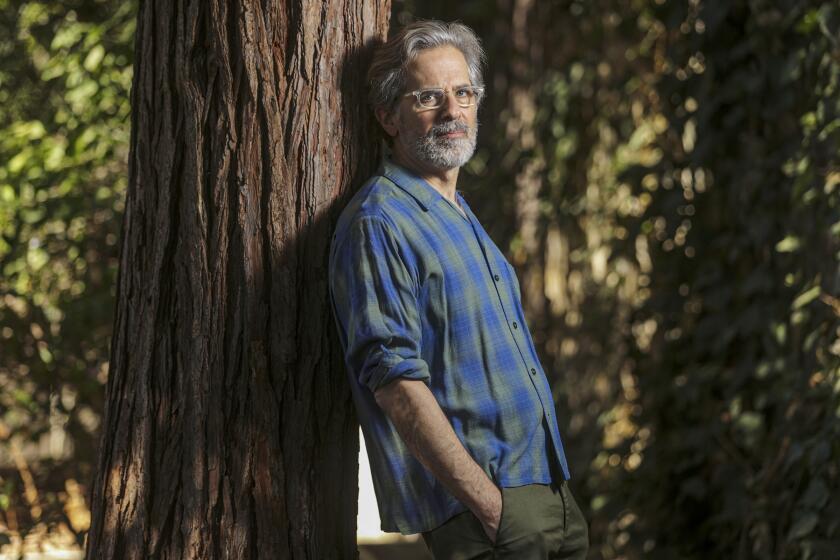Review: Kazuo Ishiguro’s new novel is one of his very best
On the Shelf
Klara and the Sun
By Kazuo Ishiguro
Knopf: 320 pages, $28
If you buy books linked on our site, The Times may earn a commission from Bookshop.org, whose fees support independent bookstores.
How will computers remember this time? Assuming they achieve consciousness in some form — what’s usually called the singularity — then we are currently inhabiting their prehistory. The first machines with affect and consciousness will be confronted with an enormous record of their ancestry, but only humans upon whom to model their behavior. And we are an error-prone bunch, mercurial, confusing, not notably peaceable. Baffling, even.
This is the subject of Kazuo Ishiguro’s moving and beautiful new novel, “Klara and the Sun.” Many novelists have grappled with it, but Ishiguro is not many other novelists. “A painting is not a picture of an experience,” the artist Mark Rothko once said, “it’s the experience.” Ishiguro’s books are the experience.
His first two novels, “A Pale View of Hills” and “An Artist of the Floating World,” both had as their subject Japan, the country from which he moved to England when he was 5. (His father was an oceanographer, a profession — with its suggestion of deep soundings, its interest in the unknown — that seemed to have a lineal relationship with his son’s searching fiction.) These first books are magnificent — no apprenticeship, straight to mastery — and established Ishiguro’s familiar style, in which a narrator gradually tries to piece together enigmatic events that may be central to his or her identity.
Gaining in reputation, the author then settled into a run of greatness with few parallels among living writers: “The Remains of the Day,” “The Unconsoled,” “When We Were Orphans” and “Never Let Me Go” — four novels, each with an argument to be a masterpiece. The first made him famous; the second is a difficult but rewarding favorite of some readers, myself included; the third is a furious laceration of imperialism, oft-misunderstood; and as for “Never Let Me Go,” it is probably, thus far, the most important English-language novel of the new century.
It’s also the Ishiguro novel closest in theme and tone to “Klara and the Sun.” Both are about what we can hold on to as “human” once the idea of being a human begins to change; both are also, like all his work, about the simpler question of what being human ever was to begin with.
The return to this subject was by no means inevitable. Since “Never Let Me Go” came out in 2005, Ishiguro has published a story collection called “Nocturnes” (whose opening stories rank with the best of his work) and an Arthurian fable that divided readers, “The Buried Giant.” He also won the Nobel Prize in 2017 — they don’t always get it right, but there was universal consensus that in this instance they had — and went to Buckingham Palace to be knighted.
That trajectory left open the question of where his work would go next. Now we have a resounding answer: “Klara and the Sun,” an unequivocal return to form, a meditation in the subtlest shades on the subject of whether our species will be able to live with everything it has created.
The book begins with Klara, its narrator, waiting in a store, hoping to be noticed by the right child. She’s an AF, or artificial friend, an expensive companion in a world even more economically stratified than our present one.
But she’s an unusually bright AF. “Klara has so many unique qualities, we could be here all morning,” her caring manager tells a customer. “But if I had to emphasize just one, well, it would have to be her appetite for observing and learning.” This makes Klara a classic Ishiguroan narrator, like the butler Stevens in “The Remains of the Day” or Etsuko in “A Pale View of Hills” — forced to read the world carefully for signs in order to survive.
Soon a child does choose Klara. Her name is Josie, a girl on the verge of adolescence, and as we try to make out who she and her mother are from the limited clues Klara can assemble, we learn two things about her. The first is that she’s “lifted,” which is a good thing. (Her only close friend besides Klara, her neighbor Rick, is not so lucky: “Such a shame a boy like that should have missed out,” an adult murmurs about him.) The second is that she’s sick.
It’s Klara’s job to keep Josie company, but as her empathetic capacities grow, it becomes her mission to restore Josie to health too. Klara must contend with various humans around Josie who have other designs — her loving but slightly sinister mother; her father, an engineer who has been “substituted” (by robots, we eventually piece together) and absconded to a free human community; and Rick, who loves Josie but is initially wary of Klara.
Ishiguro’s best books are hard to summarize with any justice past the first hundred pages because, like a handful of other great writers — Louise Erdrich, Dostoevsky — he is almost incidentally one of the best pure mystery novelists around. With just a few words (“lifted,” here, and terms as anodyne as “completion” and “his daughter and her boy” in other novels) he creates ambiguities that make most of his books feverish reads, one-sitters.
It’s already snowing in Minnesota, where Louise Erdrich lives, by mid-October.
“Klara and the Sun” is among them. As soon as one mystery clarifies, another is born. Ishiguro’s signature is the crucial though seemingly insignificant anecdote — the visit to the tea shop in “Orphans,” the cassette in “Never Let Me Go” — and as Klara, by design pure of heart, pieces them together, she realizes with sadness how “humans, in their wish to escape loneliness, made maneuvers that were complex and hard to fathom.” The devastating final scenes of the novel, which recount the period after Klara’s service has ended, are about the price of those maneuvers.
“Klara and the Sun” is a distinctly “mature” novel — as assured as ever, but slapdash in places compared to the author’s meticulous earlier work. And he’s never been strong with dialogue (his books are so profoundly interior). But these minor criticisms glance off Ishiguro’s work like bullets off the hull of a battleship. Few writers who’ve ever lived have been able to create moods of transience, loss and existential self-doubt as Ishiguro has — not art about the feelings, but the feelings themselves.
How? There are technical answers, to be sure, but there are also emotional ones. “In memory of my mother Shuzuko Ishiguro,” reads the dedication to this new novel. “1926-2019.” Ishiguro has lost the mother with whom he moved to England more than 60 years ago. It set off a pang in my heart to learn it, though I know virtually nothing about the author beyond the little he has revealed in interviews.
Still, it’s so easy to imagine a sensitive and intelligent boy, born in Nagasaki nine years after the city was briefly and horrifically as hot as the sun; imagine him relocated to a completely alien country; imagine how incredibly alert he had to be, at high cost, to understand it. You could imagine that boy growing up to become a lauded novelist, then his mother dying; and you could imagine him then writing a novel about love and selflessness and prayer and calling it “Klara and the Sun.”
But that is rank psychologizing. Because, of course, the point of feeling we can guess about his designs isn’t that we understand Kazuo Ishiguro. It’s that he understands us. There is something special about Josie, Klara realizes. “But it wasn’t inside Josie,” she reflects. “It was inside those who loved her.”
The novelist perhaps most associated with Brooklyn lives in Claremont and has a delightful new dystopian novel out, “The Arrest”
Finch’s novels include the Charles Lenox mysteries.
More to Read
Sign up for our Book Club newsletter
Get the latest news, events and more from the Los Angeles Times Book Club, and help us get L.A. reading and talking.
You may occasionally receive promotional content from the Los Angeles Times.







